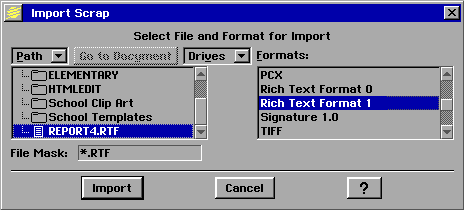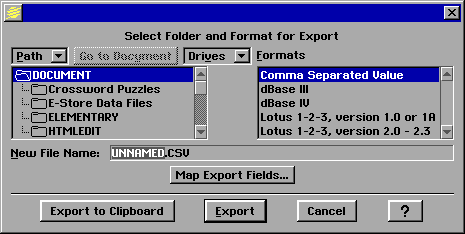NewDeal Technical Support Document 204
IMPORT AND EXPORT FORMATS
File formats that can be Imported to and
Exported from NewDeal software
With NewDeal you can use document files created by many other softwares,
including word processing documents, spreadsheets, databases, and
graphics. You might obtain files from a friend or coworker on disk
or attached to an email message, or you might download them from the
Internet. To open a file created by another software, you use the
Import feature.
You can share documents that you create in NewDeal with friends and
associates who have computers, but do not have NewDeal software,
by saving copies of your NewDeal documents in a format supported
by their software and sending the resulting files by email or
sharing them on disk or on a network server. To save a document
in another format, you use the Export feature.
To import a file
- If you know the type of file you are trying to import, open
the appropriate application.
- For plain text files (sometimes called ASCII files), use Text
File Editor or NewWrite.
- For word processing files, use NewWrite.
- For spreadsheet files, use NewCalc or NewFile.
- For database files, use NewFile, NewCalc, or NewDex.
- For graphics files, use NewDraw.
- If you are unsure of the file type, use Scrapbook.
- In NewWrite, NewCalc, NewFile, or NewDex, choose Import from
the New/Open dialog box. In NewDraw or Scrapbook, choose Import
from the File menu. The Import dialog box appears.
(In Text File Editor, choose Open in the File menu, then locate
and open the file from the standard file selector.)

- The right side of the Import dialog box contains a list of
the available formats for import. The Formats list includes only
those formats appropriate for the application you are using. For
example, NewWrite can import only word processor files and NewDraw
can import only graphics files. Scrapbook can import all supported
file types. In the list of formats, select the format of the file
you are importing. If you are unsure of the format, choose No Idea
(Auto-Detect).
- Locate the file you want to import using the standard file selector
in the left side of the Import dialog box. Press the Import button
to begin the import process.
Note: After selecting a format, the standard file selector displays
a File Mask and only files with the appropriate file name extension
appear in the file selector. For example, if you choose Comma
Separated Value as your import type, the file mask is *.CSV. Only
files with file name extension .CSV are displayed. If the file mask
is incorrect for the file you want to import, edit the file mask
and press the Enter key on your keyboard. Then choose the file you
want to import.
For more help, press the help button in the dialog box.
About importing word processing files
When importing files created by word processors, only the text
will be imported. In most cases, text attributes like fonts,
styles, sizes, and the layout of the text are included. If the
styles or layout of the imported file do not match the original
file exactly, you can usually fix things with a few moments of
editing.
If the file you are importing contains graphics, the graphics are
ignored. If you want the graphics, ask the author of the original
file to export them separately in a format which you can import
into Scrapbook, then copy them from the Scrapbook and paste them
back into the document in NewWrite.
If the file you want to import is in a format that is not in
NewDeal's list of supported import formats, ask the author of
the file to export it to a format that NewDeal does support. Most
word processors can export their files to supported formats like
WordPerfect 5.1 or Rich Text Format. For example, if your friend
has created a document in Word for Windows, ask her to save the
document in Rich Text Format for you.
About importing graphics files
NewDeal can import several different bitmap graphics formats,
including .TIF, .PCX, .BMP, etc. The graphics files must not be
compressed and must be in a format that provides no more than 256
colors. If the graphics you want to import are in a format which
supports more than 256 colors or if the colors of your imported
graphics do not match the originals, try opening the files with
Media Viewer. If you can open the files in Media Viewer, you can
copy them to the clipboard and paste them into your documents.
About importing spreadsheet and database files
Spreadsheet and database files are often interchangeable. When you
import a database file into a spreadsheet, each record becomes a
row and each field becomes a column. If you import a spreadsheet
document into NewFile, each row of the spreadsheet will become a
record and each column will become a field. Depending on the
spreadsheet, it may or may not make sense to import the data
into NewFile.
If you wish to import a file created in Quattro Pro or Excel, ask
the author to save the file in Lotus 123 or dBase format.
When importing a database file, the Import dialog box may contain
a button named Map Import Fields. Press this button if you want
ignore some fields or if you want to rearrange the order of the
fields when you import the database. For instructions about how
to map fields, press the help button in the Map Import Fields
dialog box.
A tip: When you import a Comma Separated Value (.CSV) file into
NewCalc, numbers in the CSV file will be imported as text strings.
As a work around, first import the CSV file into NewFile, where you
can change the field type from General/Text to Integer or Real Number.
Then export the data as a Lotus 123 or dBase file. Finally, import
the Lotus 123 or dBase file into NewCalc.
To export a file
- In NewWrite, NewFile, NewCalc, or NewDex choose Other from the
File menu. In the Other menu, choose Export Document. In NewDraw,
choose Export Graphic from the File menu. The Export dialog box appears.

- In the dialog box, select the format you want to export to.
Select the folder where you want to create the exported file and
enter a name for the file.
- If the dialog box contains additional options, configure
them as appropriate. Then press the Export button. The dialog
box disappears and the export file is created.
For more help, press the help button in the dialog box.
About exporting NewWrite documents
Keep in mind that graphics will not be exported. If your NewWrite
document contains graphics that you wish to export, copy and
paste them into NewDraw and export them from NewDraw as separate
files.
If the intended recipient of your file does not have one of the
softwares listed in the export formats, try Rich Text Format.
Most word processors will import Rich Text Format with fonts,
styles, and layout intact. Rich Text Format 1 is a more modern
version which preserves more of the formatting than Rich Text Format 0.
About exporting NewDex documents
When you export a NewDex file to a database format, line breaks
and carriage returns in the Addr_Field and in the Notes_Field
are lost.
About exporting NewDraw documents
Objects in NewDraw are exported at 72 dots per inch. If you wish
to export at a higher resolution, scale your NewDraw objects
larger before exporting them.
About exporting NewCalc and NewFile documents
If your spreadsheet or database includes formulas, export to
Lotus 123 or dBase format instead of Comma Separate Value format.
If you want to change the order of fields, or leave out fields,
export to CSV or dBase format and press the Map Export Fields
button in the Export dialog box. For more help with mapping fields,
press the help button in the Map Export Fields dialog box.
Word Processor Formats
ASCII or Plain Text
Lotus 1-2-3 1.0 or 1A as text
Lotus 1-2-3 2.0 - 2.3 as text
Microsoft Word 3.0 (DOS Version)
Microsoft Word 4.0 (DOS Version)
Microsoft Word 5.0 & 5.5 (DOS Version)
MultiMate 3.3
MultiMate 4.0
MultiMate Advantage
MultiMate Advantage II
Rich Text Format
Signature 1.0
Word Perfect 5.0
Word Perfect 5.1
Word Perfect For Windows 5.1
WordStar 3.45 or below
WordStar 4.0
WordStar 5.0
WordStar 5.5
WordStar 6.0
WordStar 7.0
XYWrite III
XYWrite III Plus
Spreadsheet and Database Formats
Comma Separated Value
dBase III
dBase IV
Lotus 1-2-3, version 1.0 or 1A
Lotus 1-2-3, version 2.0 - 2.3
Graphics Formats
BMP - Windows and OS/2 bit map format
CLP - Windows clipboard
GIF - CompuServe GIF format
JPG - Joint Photographic Experts Group (through the browser)
PCX - PC Paintbrush format
TIFF - Tagged Image File Format
NewDeal software compatibility
-
Documents created with one version of NewDeal may be used with any
version of NewDeal.
-
You can upgrade any Geoworks document file for use with NewDeal software.
-
Fonts that work in Geoworks are compatible with NewDeal software.
-
Third-party applications that work with Geoworks Ensemble 2.0 will run under
NewDeal software.
-
NewDeal software is fully compatible with MS DOS 3.x and above and OS/2.
-
NewDeal software works with Windows 3.1, Windows 3.11 and Windows 95 or
98 or NT as a full screen DOS application.
-
NewDeal software is compatible with over 700 dot matrix, ink jet, laser,
and PostScript printers. See technical support document
205.
Last Modified 26 Mar 1999

